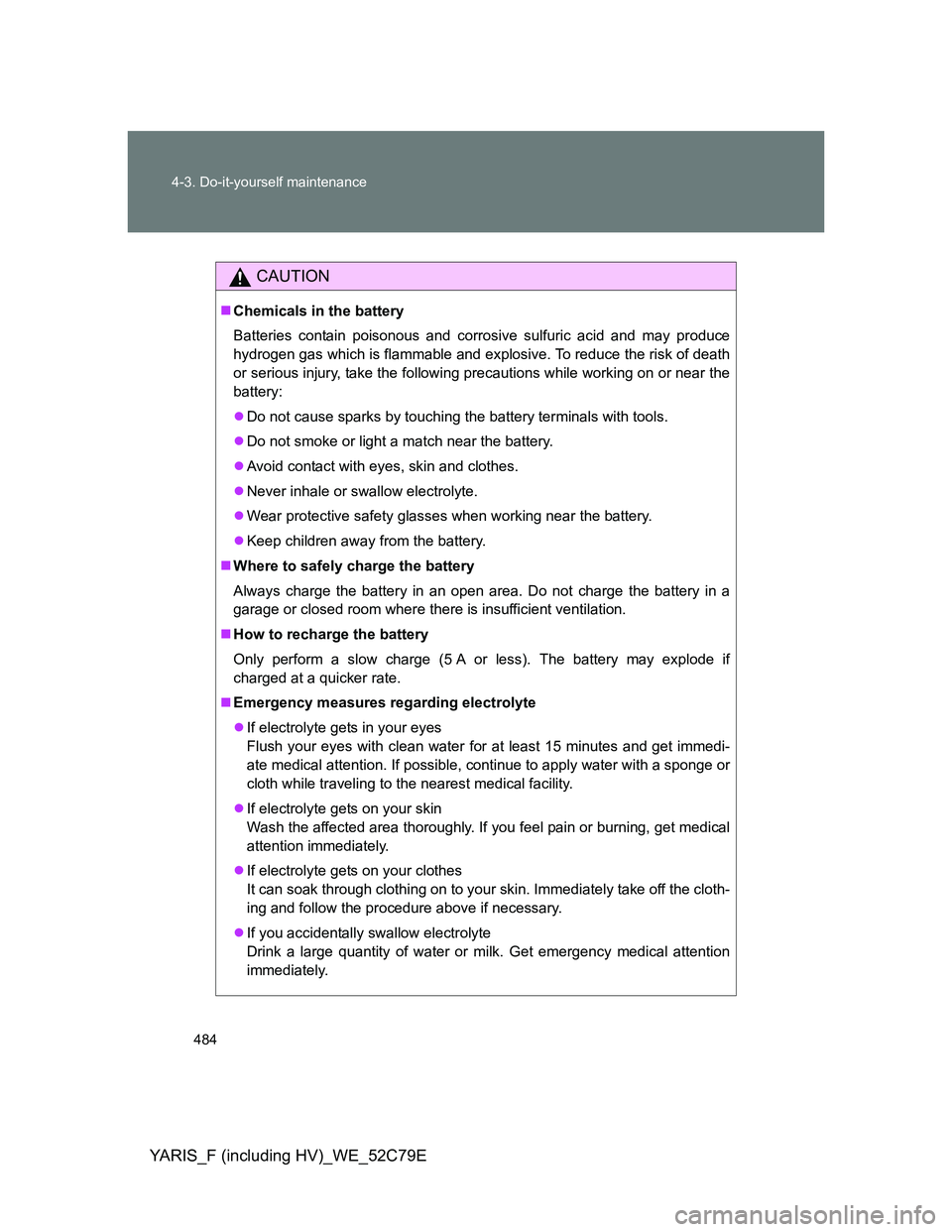Page 467 of 704
467
4-3. Do-it-yourself maintenance
4
Maintenance and care
YARIS_F (including HV)_WE_52C79E
Engine compartment
1KR-FE engine
Fuse boxes (P. 510)
Engine oil level dipstick
(P. 471)
Engine oil filler cap
(P. 474)
Battery (P. 482)Engine coolant reservoir
(P. 478)
Electric cooling fan
Condenser (P. 481)
Radiator (P. 481)
Washer fluid tank (P. 485)
Page 468 of 704
468 4-3. Do-it-yourself maintenance
YARIS_F (including HV)_WE_52C79E
1NR-FE engine
Fuse boxes (P. 510)
Engine oil filler cap
(P. 474)
Engine oil level dipstick
(P. 471)
Battery (P. 482)Engine coolant reservoir
(P. 478)
Electric cooling fan
Condenser (P. 481)
Radiator (P. 481)
Washer fluid tank (P. 485)
Page 469 of 704
469 4-3. Do-it-yourself maintenance
4
Maintenance and care
YARIS_F (including HV)_WE_52C79E
1ND-TV engine
Fuse boxes (P. 510)
Engine oil filler cap
(P. 474)
Engine oil level dipstick
(P. 471)
Fuel filter (P. 486)
Battery (P. 482)Intercooler (P. 481)
Electric cooling fan
Condenser (P. 481)
Radiator (P. 481)
Engine coolant reservoir
(P. 478)
Washer fluid tank (P. 485)
Page 482 of 704
482 4-3. Do-it-yourself maintenance
YARIS_F (including HV)_WE_52C79E
Battery (except hybrid vehicle)
Check the battery as follows:
Caution symbols
The meanings of each caution symbol on the top of the battery are as
follows:
Battery exterior
Make sure that the battery terminals are not corroded and that
there are no loose connections, cracks, or loose clamps.
Terminals
Hold-down clamp
No smoking, no naked
flames, no sparksBattery acid
Shield eyesNote operating
instructions
Keep away from childrenExplosive gas
Page 483 of 704

483 4-3. Do-it-yourself maintenance
4
Maintenance and care
YARIS_F (including HV)_WE_52C79E
Before recharging
When recharging, the battery produces hydrogen gas which is flammable
and explosive. Therefore, observe the following before recharging:
If recharging with the battery installed on the vehicle, be sure to discon-
nect the ground cable.
Make sure the power switch on the charger is off when connecting and
disconnecting the charger cables to the battery.
After recharging/reconnecting the battery (vehicles with a smart entry
& start system)
Unlocking the doors using the smart entry & start system may not be
possible immediately after reconnecting the battery. If this happens, use
the wireless remote control or the mechanical key to lock/unlock the
doors.
Start the engine with the “ENGINE START STOP” switch in ACCES-
SORY mode. The engine may not start with the “ENGINE START STOP”
switch turned off. However, the engine will operate normally from the sec-
ond attempt.
The “ENGINE START STOP” switch mode is recorded by the vehicle. If
the battery is reconnected, the vehicle will return the “ENGINE START
STOP” switch mode to the status it was in before the battery was discon-
nected. Make sure to turn off the engine before disconnect the battery.
Take extra care when connecting the battery if the “ENGINE START
STOP” switch mode prior to discharge is unknown.
If the engine will not start even after multiple attempts, contact any autho-
rized Toyota dealer or repairer, or another duly qualified and equipped pro-
fessional.
Page 484 of 704

484 4-3. Do-it-yourself maintenance
YARIS_F (including HV)_WE_52C79E
CAUTION
Chemicals in the battery
Batteries contain poisonous and corrosive sulfuric acid and may produce
hydrogen gas which is flammable and explosive. To reduce the risk of death
or serious injury, take the following precautions while working on or near the
battery:
Do not cause sparks by touching the battery terminals with tools.
Do not smoke or light a match near the battery.
Avoid contact with eyes, skin and clothes.
Never inhale or swallow electrolyte.
Wear protective safety glasses when working near the battery.
Keep children away from the battery.
Where to safely charge the battery
Always charge the battery in an open area. Do not charge the battery in a
garage or closed room where there is insufficient ventilation.
How to recharge the battery
Only perform a slow charge (5 A or less). The battery may explode if
charged at a quicker rate.
Emergency measures regarding electrolyte
If electrolyte gets in your eyes
Flush your eyes with clean water for at least 15 minutes and get immedi-
ate medical attention. If possible, continue to apply water with a sponge or
cloth while traveling to the nearest medical facility.
If electrolyte gets on your skin
Wash the affected area thoroughly. If you feel pain or burning, get medical
attention immediately.
If electrolyte gets on your clothes
It can soak through clothing on to your skin. Immediately take off the cloth-
ing and follow the procedure above if necessary.
If you accidentally swallow electrolyte
Drink a large quantity of water or milk. Get emergency medical attention
immediately.
Page 485 of 704
485 4-3. Do-it-yourself maintenance
4
Maintenance and care
YARIS_F (including HV)_WE_52C79E
Washer fluid
If the washer fluid level is less
than “FULL” line, add washer
fluid to “FULL” line.
NOTICE
When recharging the battery
Never recharge the battery while the engine is running. Also, be sure all
accessories are turned off.
CAUTION
When adding washer fluid
Do not add washer fluid when the engine is hot or running (except hybrid
vehicle) or the hybrid system is hot or operating (hybrid vehicle) as washer
fluid contains alcohol and may catch fire if spilled on the engine etc.
NOTICE
Do not use any fluid other than washer fluid
Do not use soapy water or engine antifreeze instead of washer fluid.
Doing so may cause streaking on the vehicle’s painted surfaces.
Diluting washer fluid
Dilute washer fluid with water as necessary.
Refer to the freezing temperatures listed on the label of the washer fluid bot-
tle.
Page 487 of 704
487
4-3. Do-it-yourself maintenance
4
Maintenance and care
YARIS_F (including HV)_WE_52C79E
12-volt batter y (hybrid vehicle)
Location
The 12-volt battery is located
under the rear right seat.
Removing the 12-volt battery cover
Ty p e A
Remove the cover after
removing the clips.
Ty p e B
Remove the cover after
removing the clips.